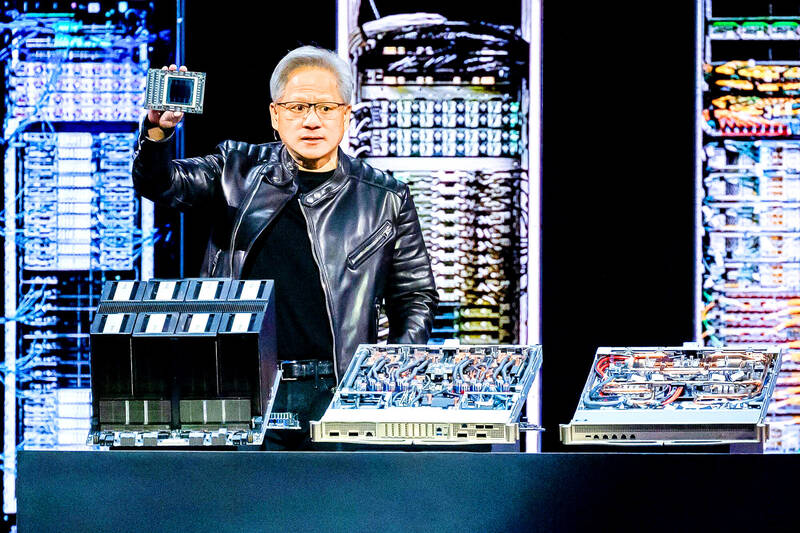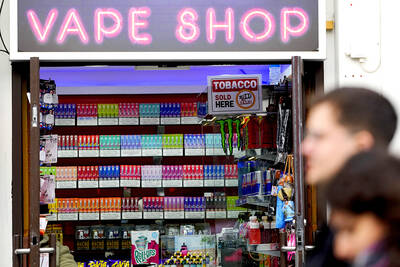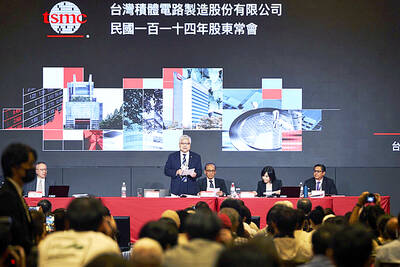Nvidia Corp chief executive officer Jensen Huang (黃仁勳) on Tuesday used his annual GPU Technology Conference (GTC) to address concerns that the cost of artificial intelligence (AI) computing is spiraling out of control.
Huang at the GTC unveiled more powerful chips and related technology that he said would provide a clearer payoff to customers. The lineup includes a successor to Nvidia’s flagship AI processor called the Blackwell Ultra, as well as additional generations stretching into 2027.
The new Blackwell Ultra processor lineup would arrive in the second half of this year, and would be followed by a more dramatic upgrade called Vera Rubin in the latter half of next year, and Rubin Ultra in 2027, he said.

Photo: Bloomberg
Vera Rubin’s namesake was an American astronomer credited with helping discover the existence of dark matter.
Huang also unveiled Dynamo-branded software that would fine-tune existing and future equipment, making it more efficient and profitable.
“It is essentially the operating system of an AI factory,” Huang said during a roughly two-hour presentation at the GTC in San Jose, California, which touched on everything from robot technology to personal supercomputers.
The conference, once a little-known gathering of developers, has become a closely watched event since Nvidia assumed a central role in AI — with the tech world and Wall Street taking its cues from the presentation.
Huang introduced a variety of hardware, software and services during his speech, though there were no bombshell revelations for investors. Nvidia shares closed down more than 3 percent on Tuesday.
It is a pivotal moment for Nvidia. After two years of stratospheric growth for its revenue and market value, investors this year have begun to question whether the frenzy is sustainable. These concerns were brought into focus earlier this year when Chinese start-up DeepSeek (深度求索) said it had developed a competitive AI model using a fraction of the resources.
The weeklong GTC is a chance to convince the tech industry that Nvidia chips are still must-haves for AI — a field that Huang expects to spread to more of the economy in what he has called a new industrial revolution.
Dubbed the “Super Bowl of AI,” Huang offered a road map for future chips and unveiled a breakthrough system that relies on a combination of silicon and photonics — light waves.
Nvidia also announced plans for a quantum computing research lab in Boston, aiming to capitalize on another emerging technology.
Other announcements included: A partnership with General Motors Co that would add AI to next-generation cars, factories and robots; a wireless project involving companies such as T-Mobile US Inc and Cisco Systems Inc for new 6G networks; and new Nvidia-based personal supercomputer systems from Dell Technologies Inc, HP Inc and other manufacturers.
Meanwhile, Huang said the top four public cloud vendors — Amazon.com Inc, Microsoft Corp, Alphabet Inc’s Google and Oracle Corp — bought 1.3 million of Nvidia’s older-generation Hopper AI chips last year.
So far this year, the same group has bought 3.6 million Blackwell AI chips, he said, adding that he expects Nvidia’s data center infrastructure revenue to hit US$1 trillion by 2028.
At the end of his presentation, Huang introduced an open-source physics engine for robotics simulation called Newton, which is being developed with Google’s DeepMind and Walt Disney Co.
A small, boxy robot named Blue joined him on stage, popping up from a hatch in the floor. It beeped at Huang and followed his commands, standing beside him as he wrapped up his thoughts.
“The age of generalist robotics is here,” Huang said.
Additional reporting by AP

CAUTIOUS RECOVERY: While the manufacturing sector returned to growth amid the US-China trade truce, firms remain wary as uncertainty clouds the outlook, the CIER said The local manufacturing sector returned to expansion last month, as the official purchasing managers’ index (PMI) rose 2.1 points to 51.0, driven by a temporary easing in US-China trade tensions, the Chung-Hua Institution for Economic Research (CIER, 中華經濟研究院) said yesterday. The PMI gauges the health of the manufacturing industry, with readings above 50 indicating expansion and those below 50 signaling contraction. “Firms are not as pessimistic as they were in April, but they remain far from optimistic,” CIER president Lien Hsien-ming (連賢明) said at a news conference. The full impact of US tariff decisions is unlikely to become clear until later this month

Popular vape brands such as Geek Bar might get more expensive in the US — if you can find them at all. Shipments of vapes from China to the US ground to a near halt last month from a year ago, official data showed, hit by US President Donald Trump’s tariffs and a crackdown on unauthorized e-cigarettes in the world’s biggest market for smoking alternatives. That includes Geek Bar, a brand of flavored vapes that is not authorized to sell in the US, but which had been widely available due to porous import controls. One retailer, who asked not to be named, because

CHIP DUTIES: TSMC said it voiced its concerns to Washington about tariffs, telling the US commerce department that it wants ‘fair treatment’ to protect its competitiveness Taiwan Semiconductor Manufacturing Co (TSMC, 台積電) yesterday reiterated robust business prospects for this year as strong artificial intelligence (AI) chip demand from Nvidia Corp and other customers would absorb the impacts of US tariffs. “The impact of tariffs would be indirect, as the custom tax is the importers’ responsibility, not the exporters,” TSMC chairman and chief executive officer C.C. Wei (魏哲家) said at the chipmaker’s annual shareholders’ meeting in Hsinchu City. TSMC’s business could be affected if people become reluctant to buy electronics due to inflated prices, Wei said. In addition, the chipmaker has voiced its concern to the US Department of Commerce

STILL LOADED: Last year’s richest person, Quanta Computer Inc chairman Barry Lam, dropped to second place despite an 8 percent increase in his wealth to US$12.6 billion Staff writer, with CNA Daniel Tsai (蔡明忠) and Richard Tsai (蔡明興), the brothers who run Fubon Group (富邦集團), topped the Forbes list of Taiwan’s 50 richest people this year, released on Wednesday in New York. The magazine said that a stronger New Taiwan dollar pushed the combined wealth of Taiwan’s 50 richest people up 13 percent, from US$174 billion to US$197 billion, with 36 of the people on the list seeing their wealth increase. That came as Taiwan’s economy grew 4.6 percent last year, its fastest pace in three years, driven by the strong performance of the semiconductor industry, the magazine said. The Tsai